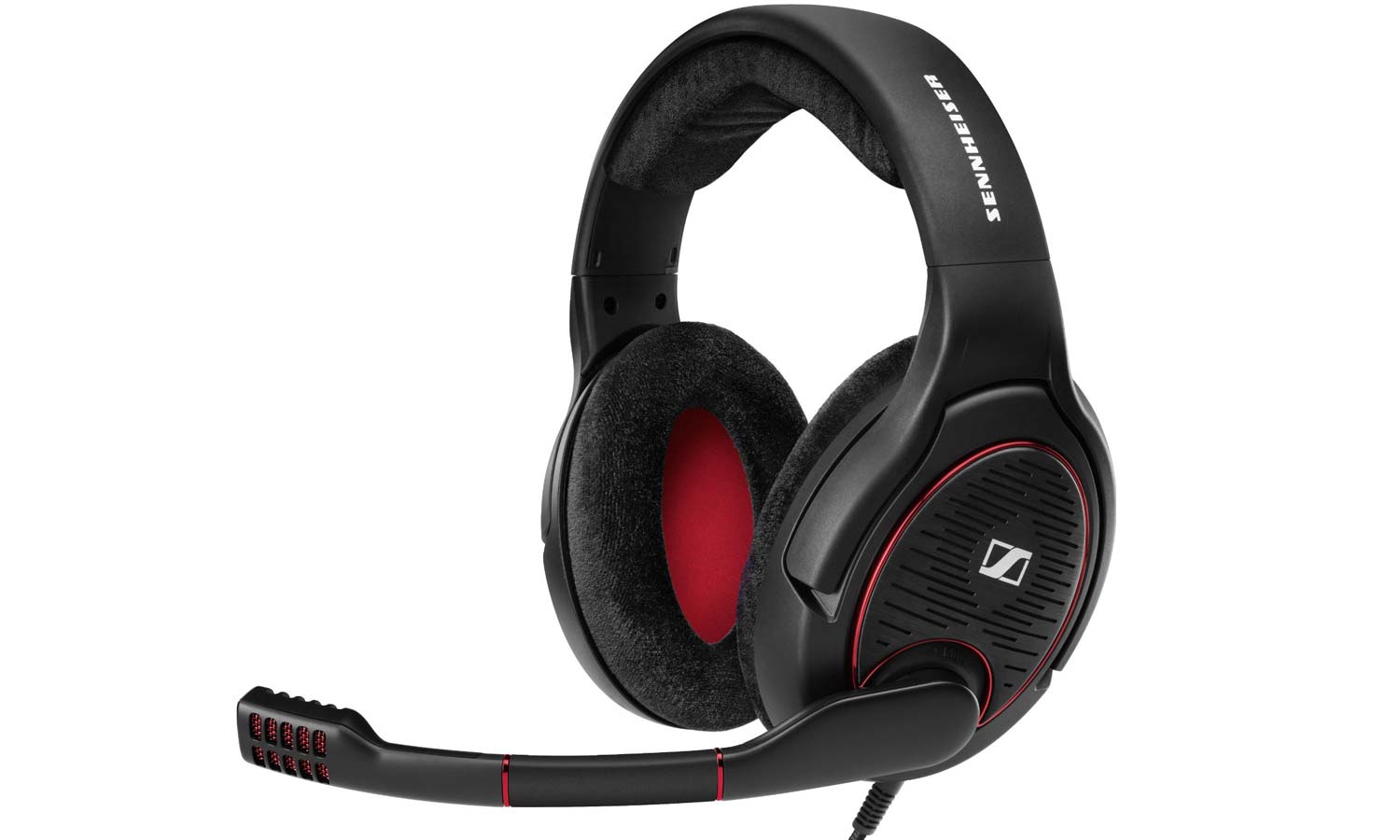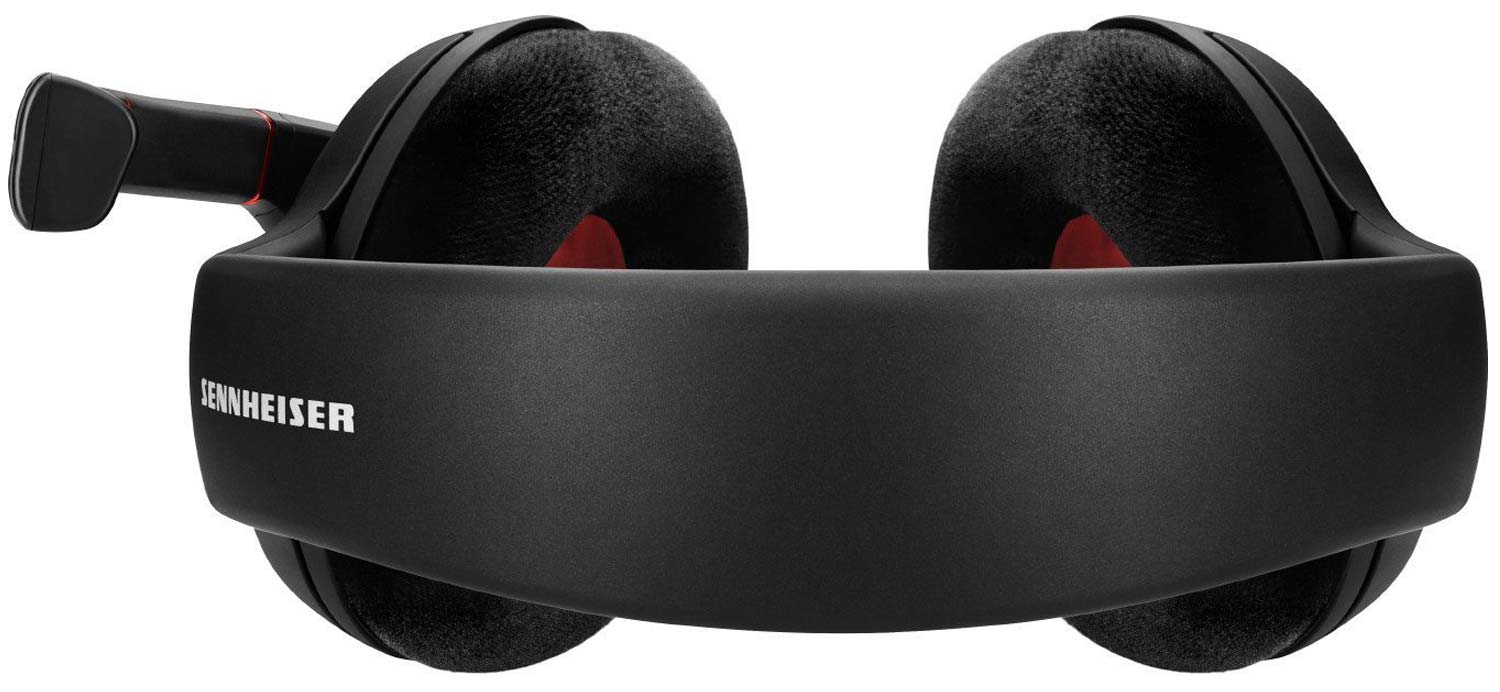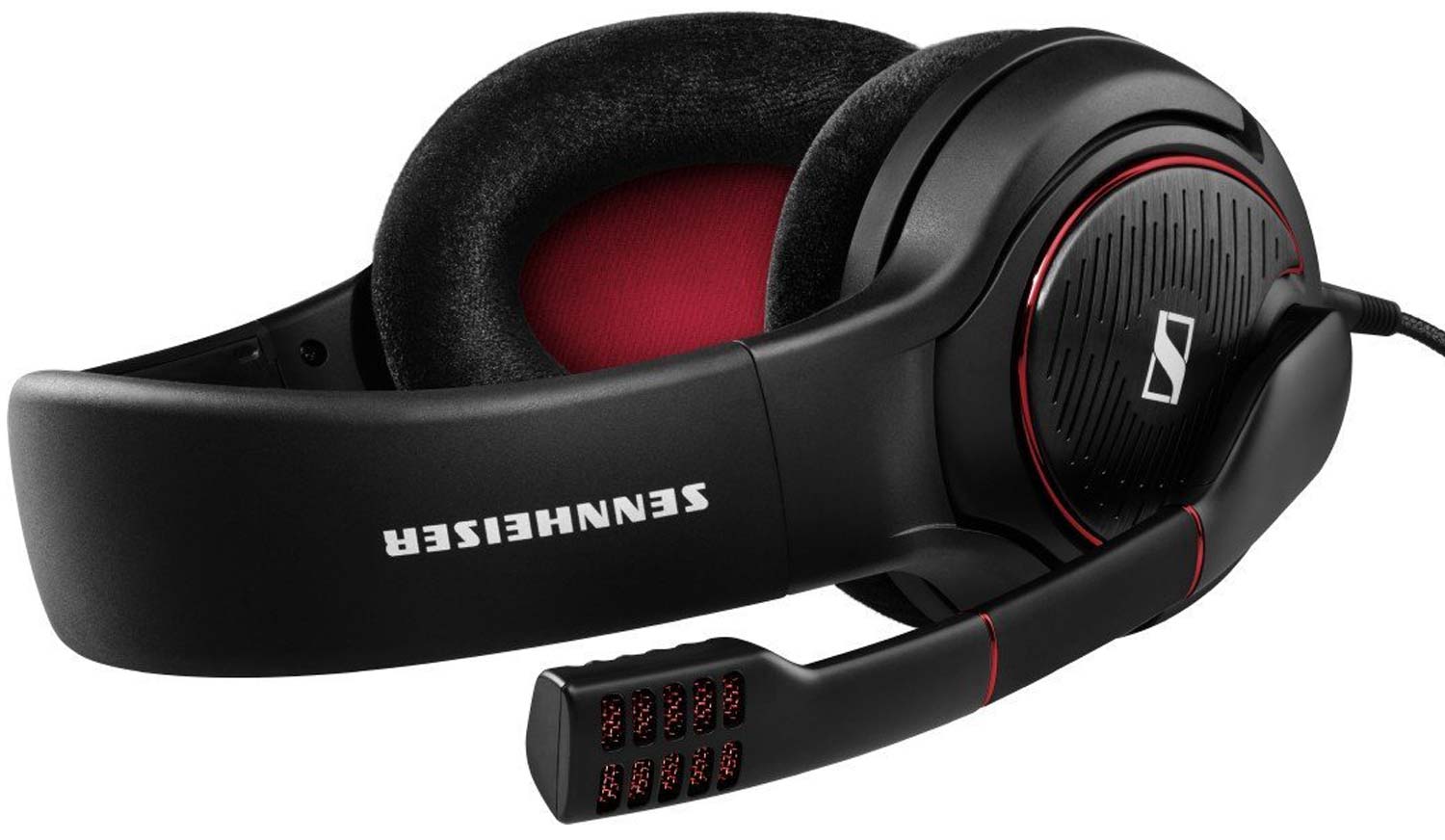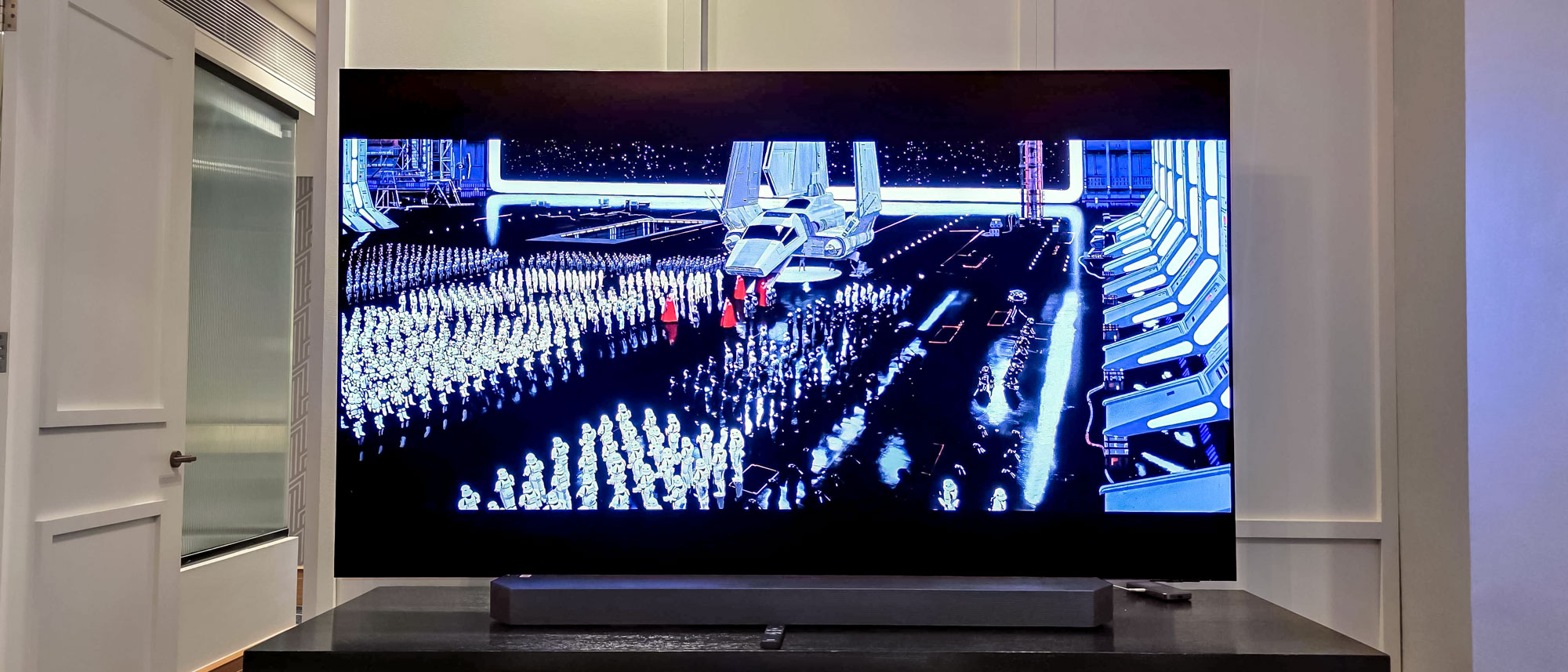Tom's Guide Verdict
The Sennheiser Game One's audio sounds good and the headset looks great, but it doesn’t really do anything to justify its premium price.
Pros
- +
Looks awesome
- +
Good in-game sound
- +
Quality mic
Cons
- -
Not very comfortable
- -
So-so music performance
- -
Way too expensive
Why you can trust Tom's Guide
I don’t know who first set the precedent that a black-and-red color scheme translates to “awesome, and maybe a little bit evil,” but I’d like to tip my hat to that person. The Sennheiser Game One headset ($250) is a slick black peripheral with just enough shiny red highlights to turn heads. The downside is that it’s the only feature about this very-decent-overall headset that’s likely to draw much attention.
The Game One's audio sounds good, but maybe not as good as a $250 headset should sound. It’s pretty, but too bulky to use while you’re out and about. It boasts lots of padding, but could feel much more comfortable. Taken as a whole, the Game One is a competent device, but it doesn’t really do anything to justify its premium price.
Design
With an all-black (or all-white) chassis and just a little red trimming, the Game One manages to look much cooler than just about any other headset channeling an over-the-top “gamer” aesthetic. The over-the-ear cups are unnecessarily large, but other than that, it’s hard to find fault with the appearance.
The Game One boasts two notable features: a boom microphone on its left ear cup and a volume control on its right ear cup. The latter is so subtle and comfortable that I hardly noticed it was there at first. The former, though, is one of the things that prevents the Game One from being a more versatile headset overall. This big, bulky extrusion is not removable, which makes it relatively difficult for you to transport the device. To take such a gorgeous headset and make it so tough to carry around every day feels like a huge, missed opportunity.
MORE: The Best Headsets for Immersive Gaming
Comfort
Caveat emptor: The Game One’s cool appearance belies the fact that it’s not very comfortable. The velvet ear cups are as breathable and plush as advertised, but the headband itself was tight when I wore it, no matter how much I adjusted it, and the ear cups pressed hard around the temples. Given how comfortable Sennheiser’s GSP 300 peripheral is, the company's sacrifice of comfort for looks in the Game One feels like a misstep.

On the other hand, I gave the Game One to a co-worker, who said that he found it incredibly comfortable, and could see himself wearing it for hours on end without any ill effects. His shaved head may have provided a more comfortable fit, while my voluminous hair got in the way. If you wear your hair in an afro, be ye fairly warned.
Game Performance
As a gaming headset, the Game One more than gets the job done. While there’s no software or amp, and thus no ability to tweak the sound, the Game One's audio provides high-quality sound across the board. Based on my testing, it can tackle any genre with high fidelity and clarity.
When I jetted around Overwatch as D.Va, soaking up damage for my team, I could hear the shouts of my teammates and the battle cries of my enemies with equal clarity. Captain America's shield gave a resounding “smack” when it ricocheted off an alien invader in Marvel Heroes. Terran ships loudly and clearly acknowledged their orders in StarCraft II, while Geralt and his companions held fascinating conversations in The Witcher 3.
MORE: Our Favorite Gaming Keyboards
The Game One shows that you don’t need fancy equalization software for gaming if you can provide excellent audio out of the box. Still, the lack of equalization options and surround sound feels like an oversight, considering the device’s hefty price. Yes, everything sounds great, but I don’t know if the sound it provides is $150 better than Sennheiser’s entry-level GSP 300 headset.
Music Performance
Compared to a comparably priced regular pair of Sennheiser headphones, the Game One's audio doesn’t sound nearly as good for music and media, which is disappointing. It doesn’t sound bad, of course: in "Carry Me Back" by Old Crow Medicine Show, I still heard the driving bass and plucky mandolin in addition to the more prominent guitar and vocals, but neither part had much snap to it. "Salty Dog" by Flogging Molly felt balanced between the accordions, drums and vocals, but it lacked the immediacy that a great pair of music headphones grants.

I had similar experiences with selections from Handel’s "Messiah." Every part in the chorus felt present, but none of them stood out. I have had much worse experiences with other gaming headsets, in which music is a complete afterthought, but I’m surprised that the Game One doesn’t offer sterling sound, considering what it costs.
You could definitely use it as your everyday music headset, unless you’re a hard-core audiophile. But a comparably priced pair of headphones will sound much better — and unless you really need the mic, they’ll work just fine for gaming, too.
Features
Without equalization options or software, the only notable features of the Game One are its volume control knob and its microphone. The volume control works fine, as discussed above. The microphone is actually quite good, providing clear, moderately loud sound, as tested in Windows Voice Recorder. There’s also some tactile feedback when you tilt it up or down, which is good, as tilting it all the way up mutes it automatically.
The Game One’s cool appearance belies the fact that it’s not very comfortable.
The Game One also comes with two swappable 3.5-millimeter audio cables: one for the separate headset/mic setup on a gaming rig, and one for the more common single jack on mobile devices or game console controllers. The audio and mic sound strong either way.
MORE: The Best PC Games to Play Right Now
Bottom Line
The Game One is a good headset overall, featuring strong, in-game sound, a quality mic and an eye-catching design. For $250, though, being good enough isn’t actually good enough. You can get headsets with comparable audio quality and many more options — like the $100 SteelSeries Arctis 5 — for a much cheaper price. The excellent Logitech G933 Artemis Spectrum costs $50 less, and the equally compelling Astro A50 is $50 more; both are wireless and offer surround sound.
If you can pick up the Game One at a sizable discount, it’s worth considering. Otherwise, go for something that's cheaper, more comfortable or comes with more options — or all three.
Marshall Honorof is a senior editor for Tom's Guide, overseeing the site's coverage of gaming hardware and software. He comes from a science writing background, having studied paleomammalogy, biological anthropology, and the history of science and technology. After hours, you can find him practicing taekwondo or doing deep dives on classic sci-fi.
-
ssddx i'm sorry but i do not find this review to be very helpful nor do i agree with it for a few reasons:Reply
-the game one is $155 now on amazon. you keep mentioning $250 (msrp) in the article and yet this is not the current price which you can actually purchase the unit at nor are products normally sold at msrp. you should be comparing it to products available in its current price range. apples to apples. yes its original msrp is much too high just like many other products msrp tend to be however compared with the going price of the 518 and 558, its really not much out of line.
-a boom mic makes a device not able to be transported? what about the 90% of headsets on the market which also do not have removable microphones. are they trash too? while i do agree a removable microphone would be nice and the fact should be noted i'm not seeing how this is a big deal.
-the game one is based on the hd518 ($80-100) or hd558 ($130) headphones and will sound very similar to those models which are well respected as being good quality at least in the entry level headphones category even by audiophiles. perhaps a little more bassy (like the hd518 vs hd558/598 sound) but still in that same region of quality. calling the game one bad sounding is like calling that line of headphones bad sounding which if you look at popular opinion is far from the truth..
-the game one (and hd518/558/598 lineup they are based on) have a more neutral sound signature to them. this is not as vibrant sounding as many gaming headsets which use a v-shape signature emphasizing treble and bass nor is it meant to be. while it may lack excitement, its also more tonally accurate. headphones and headsets with a v-shape sound signature will always be more fun sounding which is why they are marketed as such however that signature is not meant for everyone just as neutral is not meant for everyone. another thing to keep in mind is that sennheiser headphones tend to be a bit laid back sounding which is why they are very easy listening for long sessions. this means that they can sound a little slow or dull to some people but at the same time are less fatiguing than headphones which are more bright and vibrant..
-the game one is marketed as a stereo analog headset not a usb model with integrated soundcard and virtual surround. it is also not the only headset to be marketed in this way (for example the hyper x cloud). it is marketed for sound quality instead of gimmicks. want virtual surround sound just like most stereo headsets use yet claim surround sound? use your onboard or dedicated slot soundcard. those are better than the cheap ones put in usb headsets in most cases anyways.
-while i agree that the game one design may have a little clamp this can often be fixed by stretching the headband out if required. there are guides on how to do this. with this said, no headphone is perfect for every head so it may be that it just is not meant for you. also, i think it is unfair to judge soley based on a poofy hairstyle as we all know its hard to have a one-product-fits-all when it comes to heads/ears/hair.
-you speak about audiophiles not liking the game one and yet it is only one of a few headsets somewhat accepted by audiophiles. it, along with the mmx300 (based on old dt770 premium) and the ath-adg1/ag1 (based on ad500x/a500x) along with the older pc363d (based on hd555/595/pc350se) round out the very few headsets mostly based on headphone designs. in fact, the hd518 which the game one is based most on is considered one of the best budget headphones for gaming (along with the ad500x if you want bass light advantageous for fps gaming sound).
now i do realize everyone is entitled to their own opinion and opinion may vary but i feel the judgement calls were rather poor and open ended, lacking real weight. headsets/headphones are often that way - everyone has their own taste in sound while not all products fit. we see this in mice, seats, gloves. there is no universal one size fits all.
my $0.02 -
mikemefistous Those ain't $0.02 SSDDXReply
That's a full blown out review of a review.
Jokes aside. I own the headphones myself and comfort/price is not my issue.
My issue is this: Coming from logitech g35 ($80 3 year old headset with virtual 7.1 surround) i was disapointed with the GAME ONE, when it came to FPS games.
Specificaly R6S/BF1 that i tested it with. I couldn't tell where the sounds were coming from. I had no awareness and i wouldn't recommend it to any competitive gamer.
It's so bad when it comes to competitive gaming and positional audio accuracy, that i sadly have to still keep my g35 plugged in to be able to perform in those games.
Maybe i am too used in virtual audio, but my issues didn't stop with the lack of positional audio accuracy.
Whenever i tried software to get my GAME ONE, to sound virtually surround, none of them were working and all of them were causing the exact same issue.
They all sounded echoy and the sound quality instantenously got ruined.
I tried:
Razer Surround
Creative SB X-Fi 3
Some other programm that i can't remember and pretty much all 3 of them were rendering my GAME ONE headset useless.
The sound was unbearable and there was no virtual surround other than that Echo.
The sound wasn't crackling or anything, but the echo was so bad that i couldn't tell apart anything. I didn't last more than 5 minutes with any of that software before ragequiting and unintsalling them and plugging back my G35.
I am using my onboard audio but it's far from bad. My MOBO is Z170x Gaming 3. It has this onboard audio: Realtek ALC1150 115dB SNR HD Audio
with it's own pre-installed amp and swapable amps.
Another issue i encoutnered, was when turning on the amp from my MOBO, for some reason, only my right earcup took over and it sounded louder than my left one.
And it doesn't seem to be my unique case where it's happening. I've read on tom's forums 2-3 posts where other people complain about the exact same issue, of the right earcup being louder than the left, but thankfully for me, it's only occuring when i am enabling my onboard AMP, so i have to keep it off.
That said,i 'll give the headset another chance and i'll go buy a soundcard : Creative Sound Blaster Z in hopes of getting that virtual surround for games, but i doubt i'll avoid that nasty echoy artifact that all the other software for surround sound has given me. -
Vestitor I have the Game One. Use it through a Soundblaster Z and have no issue with positioning enemies in FPS games. I have friends that use Logitech G930's and I can hear details that they miss. My mobo has the same AC1150 audio but you can't configure it was much as I can with the Soundblaster Z. The controls for the Soundblaster lets me setup surround sound so that I can position whats going on in the game.Reply -
ssddx @mikeReply
sorry for the late reply (i mostly post on TH not TG)
i believe logitech uses dolby virtual surround in the g35 (dolby headphone) but you may want to check for sure. this is found on asus soundcards. creative soundcards use sbx (previously known as cmss3d). people often favor one or the other (cmss3d/sbx, dolby headphone.. not so much razer). it could very well be that you are very used to the settings used on the logitech set you had before and do not care for the new software. some people also either prefer or dislike virtual surround at all (honestly whether or not its useful depends on the game coding as well). also be aware that there is sometimes a setting to control the amount (strength) of the virtual surround sound.
keep in mind that all virtual surround sound is distorted audio of some manner (this is how virtual surround works). there will always be distortion but the echo effect would be a failure in the software not the headset.
onboard audio (such as alc1150) is not far from bad, it is mediocre at best. generally even the best onboard, even nowadays, is at best equal to low end soundcards like a xonar dg. while good quality onboard is generally not terrible and in most cases is adequate for many people lets at least be honest for a moment.
the left earcup louder than the right earcup does not necessarily point towards a headset issue. it could certainly be that your amplifier is not good and has a fault in the design. to know for sure would require testing on a known good amplifier/soundcard.
tldr;
it sounds like your issue is mostly to do with virtual surround sound. you may want to try a soundcard with dolby headphone and adjust it to suit your preferences.


